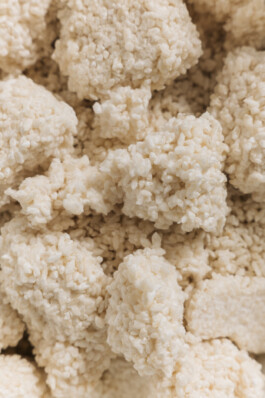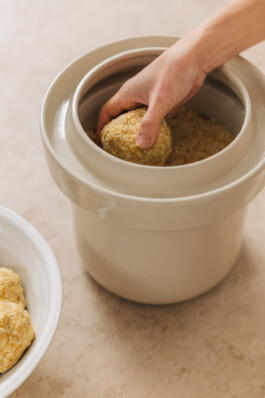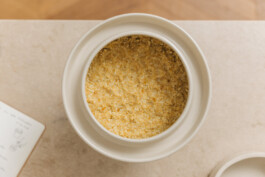
Fermented Bread Paste / Breadso / Bread Miso
Miso is traditionally made by fermenting soybeans with salt and kōji.
However, instead of soybeans you can try out various ingredients like organic sourdough bread (Breadso), freekeh, whole grain green spelt, brown wholemeal rice, (black) chickpeas or (yellow) peas (Peaso), they will all create fully different flavour profiles from savory and earthy to sweet and fruity.
Kōji is the base for culturing miso and many other fermented foods and sesonings like Tamari, soy sauce, and shoyu. You need a kōji starter (Aspergillus Oryzae), rice, oatmeal or barley, a steaming basket, wooden tray and the right climate. You can get great kome kōji (steamed and fermented rice infused with fungus Aspergillus Oryzae) from mimi ferments if you don't want to make it yourself.
You can find the original Breadso recipe in the book Foundations of Flavor that is listed under resources. The kōji is grown there directly on the bread. I do it a bit different here and just add it to the bread.
If you want to know more about kōji in general I highly recommend the book "Kōji Alchemy: Rediscovering the Magic of Mold-Based Fermentation" by Jeremy Umansky and Rich Shih. There you can also find great recipes for miso.
PREPARATION
1. Cut the bread into cubes. You can cut off the crust and keep it for Knödel or breadcrumbs.
2. Steam the bread for 5 minutes and let it rest.
3. Add water and salt to it. Knead the bread until everything is combined.
4. Add the kōji, mix everything and continue kneading before you put it through a food processor (mincer / grinder).
5. Now you can form balls out of the mass and place them onto a plate.
6. Throw the balls carefully into the jar to avoid air pockets, especially in the edges.
7. Sprinkle the last layer with a good amount of salt.
8. Now place the fermentation weights on top and let it ferment for at least 2 months, better 6 to 12 for a more intensive umami flavour.
Notes
The base choice is entirely up to you. If you want to try a miso with soybeans or green spelt instead, you need to steam or boil it first and let it cool down for a bit before you process it. The rest of the process remains more or less the same, but the water salt ratio will be different.
The ratio of kōji to base to salt depends on the flavor and fermentation time you aim for. For a short-term fermented light miso, (2 weeks to 3 months), you need more koji and less salt, for a long-term fermented darker umami miso (from 6 months to years), you need a more protein and more salt.
A light miso requires 1 part koji + 1 part base (by weight), plus 5-6 % salt and a darker, long-term fermented miso requires 1 part koji to 2 parts base + 13 % salt.
Enjoy!





Fermented Bread Paste / Breadso / Bread Miso
Miso is traditionally made by fermenting soybeans with salt and kōji.
However, instead of soybeans you can try out various ingredients like organic sourdough bread (Breadso), freekeh, whole grain green spelt, brown wholemeal rice, (black) chickpeas or (yellow) peas (Peaso), they will all create fully different flavour profiles from savory and earthy to sweet and fruity.
Kōji is the base for culturing miso and many other fermented foods and sesonings like Tamari, soy sauce, and shoyu. You need a kōji starter (Aspergillus Oryzae), rice, oatmeal or barley, a steaming basket, wooden tray and the right climate. You can get great kome kōji (steamed and fermented rice infused with fungus Aspergillus Oryzae) from mimi ferments if you don't want to make it yourself.
You can find the original Breadso recipe in the book Foundations of Flavor that is listed under resources. The kōji is grown there directly on the bread. I do it a bit different here and just add it to the bread.
If you want to know more about kōji in general I highly recommend the book "Kōji Alchemy: Rediscovering the Magic of Mold-Based Fermentation" by Jeremy Umansky and Rich Shih. There you can also find great recipes for miso.
PREPARATION
1. Cut the bread into cubes. You can cut off the crust and keep it for Knödel or breadcrumbs.
2. Steam the bread for 5 minutes and let it rest.
3. Add water and salt to it. Knead the bread until everything is combined.
4. Add the kōji, mix everything and continue kneading before you put it through a food processor (mincer / grinder).
5. Now you can form balls out of the mass and place them onto a plate.
6. Throw the balls carefully into the jar to avoid air pockets, especially in the edges.
7. Sprinkle the last layer with a good amount of salt.
8. Now place the fermentation weights on top and let it ferment for at least 2 months, better 6 to 12 for a more intensive umami flavour.
Notes
The base choice is entirely up to you. If you want to try a miso with soybeans or green spelt instead, you need to steam or boil it first and let it cool down for a bit before you process it. The rest of the process remains more or less the same, but the water salt ratio will be different.
The ratio of kōji to base to salt depends on the flavor and fermentation time you aim for. For a short-term fermented light miso, (2 weeks to 3 months), you need more koji and less salt, for a long-term fermented darker umami miso (from 6 months to years), you need a more protein and more salt.
A light miso requires 1 part koji + 1 part base (by weight), plus 5-6 % salt and a darker, long-term fermented miso requires 1 part koji to 2 parts base + 13 % salt.
Enjoy!
a pinch of salt
c/o Tamara Pešić
Ludwigstraße 197
63067 Offenbach
Germany
Pick up & drop times:
Wed, 16:00–19:00
Sat, 13:00–16:00
© Copyright 2022
a pinch of salt
c/o Tamara Pešić
Ludwigstraße 197
63067 Offenbach
Germany
Pick up & drop times:
Wed, 16:00–19:00
Sat, 13:00–16:00
© Copyright 2022